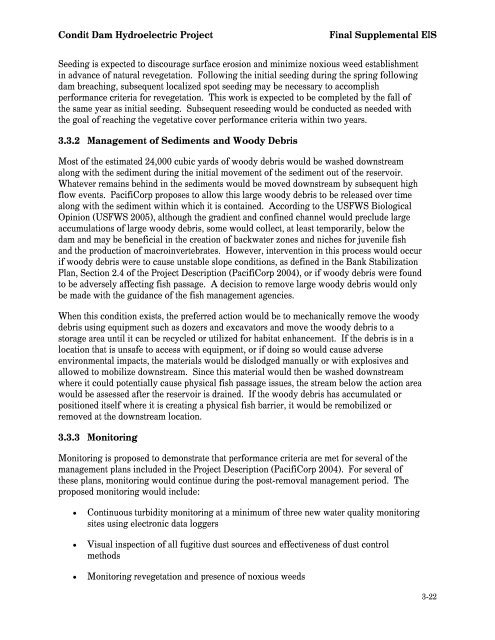Condit Dam Removal Condit Dam Removal - Access Washington
Condit Dam Removal Condit Dam Removal - Access Washington
Condit Dam Removal Condit Dam Removal - Access Washington
Create successful ePaper yourself
Turn your PDF publications into a flip-book with our unique Google optimized e-Paper software.
<strong>Condit</strong> <strong>Dam</strong> Hydroelectric Project<br />
Final Supplemental EIS<br />
Seeding is expected to discourage surface erosion and minimize noxious weed establishment<br />
in advance of natural revegetation. Following the initial seeding during the spring following<br />
dam breaching, subsequent localized spot seeding may be necessary to accomplish<br />
performance criteria for revegetation. This work is expected to be completed by the fall of<br />
the same year as initial seeding. Subsequent reseeding would be conducted as needed with<br />
the goal of reaching the vegetative cover performance criteria within two years.<br />
3.3.2 Management of Sediments and Woody Debris<br />
Most of the estimated 24,000 cubic yards of woody debris would be washed downstream<br />
along with the sediment during the initial movement of the sediment out of the reservoir.<br />
Whatever remains behind in the sediments would be moved downstream by subsequent high<br />
flow events. PacifiCorp proposes to allow this large woody debris to be released over time<br />
along with the sediment within which it is contained. According to the USFWS Biological<br />
Opinion (USFWS 2005), although the gradient and confined channel would preclude large<br />
accumulations of large woody debris, some would collect, at least temporarily, below the<br />
dam and may be beneficial in the creation of backwater zones and niches for juvenile fish<br />
and the production of macroinvertebrates. However, intervention in this process would occur<br />
if woody debris were to cause unstable slope conditions, as defined in the Bank Stabilization<br />
Plan, Section 2.4 of the Project Description (PacifiCorp 2004), or if woody debris were found<br />
to be adversely affecting fish passage. A decision to remove large woody debris would only<br />
be made with the guidance of the fish management agencies.<br />
When this condition exists, the preferred action would be to mechanically remove the woody<br />
debris using equipment such as dozers and excavators and move the woody debris to a<br />
storage area until it can be recycled or utilized for habitat enhancement. If the debris is in a<br />
location that is unsafe to access with equipment, or if doing so would cause adverse<br />
environmental impacts, the materials would be dislodged manually or with explosives and<br />
allowed to mobilize downstream. Since this material would then be washed downstream<br />
where it could potentially cause physical fish passage issues, the stream below the action area<br />
would be assessed after the reservoir is drained. If the woody debris has accumulated or<br />
positioned itself where it is creating a physical fish barrier, it would be remobilized or<br />
removed at the downstream location.<br />
3.3.3 Monitoring<br />
Monitoring is proposed to demonstrate that performance criteria are met for several of the<br />
management plans included in the Project Description (PacifiCorp 2004). For several of<br />
these plans, monitoring would continue during the post-removal management period. The<br />
proposed monitoring would include:<br />
• Continuous turbidity monitoring at a minimum of three new water quality monitoring<br />
sites using electronic data loggers<br />
• Visual inspection of all fugitive dust sources and effectiveness of dust control<br />
methods<br />
• Monitoring revegetation and presence of noxious weeds<br />
3-22




